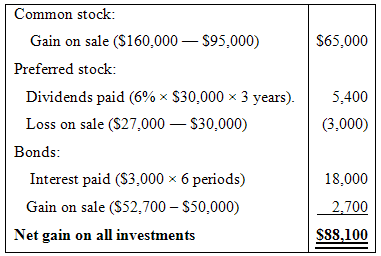Clark received $175,000 from her mothers estate. She placed the funds into the hands of a broker,
Question:
Clark received $175,000 from her mother’s estate. She placed the funds into the hands of a broker, who purchased the following securities on Linda’s behalf:
(a) Common stock was purchased at a cost of $95,000. The stock paid no dividends, but it was sold for $160,000 at the end of three years.
(b) Preferred stock was purchased at its par value of $30,000. The stock paid a 6% dividend (based on par value) each yeas for three years. At the end of three years. The stock was sold for $27,000.
(c) Bonds were purchased at a cost of $50,000. The bonds paid $3,000 in interest every six months. After three years, the bonds were sold for $52,700. (Note: In discounting a cash flow that occurs semiannually, the procedure is to halve the discount rate and double the number of periods. Use the same procedure in discounting the proceeds from the sale.)
The securities were all sold at the end of three years so that Linda would have funds available to open a new business venture. The broker stated that the investments had earned more than a 16% return, and he gave Linda the following computations to support his statement:

![]()
Required:
1. Using a 16% discount rate, compute the net present value of each of the three investments. On which investment(s) did Linda earn a 16% rate of return? (Round computations to the nearest whole dollar.)
2. Considering all three investments together, did Linda earn a 16% rate of return? Explain.
3. Linda wants to use the $239,700 proceeds ($160,000 + $27,000 + $52,700 = $239.700) from sale of the securities to open a retail store under a 12-year franchise contract. What annual net cash inflow must the store generate for Linda to earn a 14% return over the 12-year period? Round computations to the nearest whole dollar.
Net Present ValueWhat is NPV? The net present value is an important tool for capital budgeting decision to assess that an investment in a project is worthwhile or not? The net present value of a project is calculated before taking up the investment decision at... Broker
A broker is someone or something that acts as an intermediary third party, managing transactions between two other entities. A broker is a person or company authorized to buy and sell stocks or other investments. They are the ones responsible for... Discount Rate
Depending upon the context, the discount rate has two different definitions and usages. First, the discount rate refers to the interest rate charged to the commercial banks and other financial institutions for the loans they take from the Federal... Par Value
Par value is the face value of a bond. Par value is important for a bond or fixed-income instrument because it determines its maturity value as well as the dollar value of coupon payments. The market price of a bond may be above or below par,...
Step by Step Answer:

Managerial Accounting
ISBN: 978-0697789938
13th Edition
Authors: Ray H. Garrison, Eric W. Noreen, Peter C. Brewer





